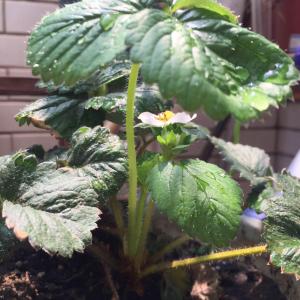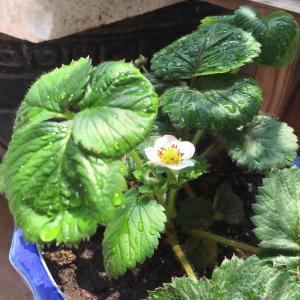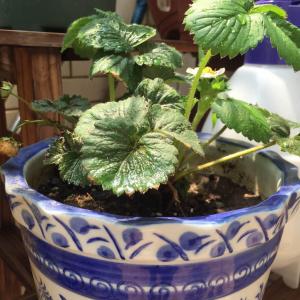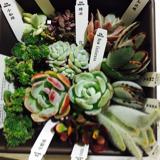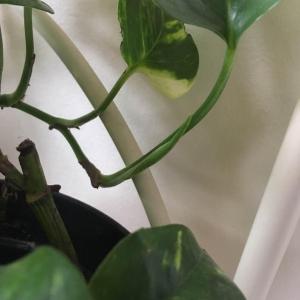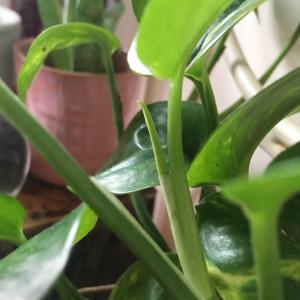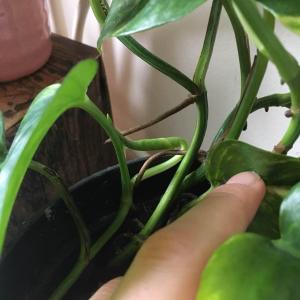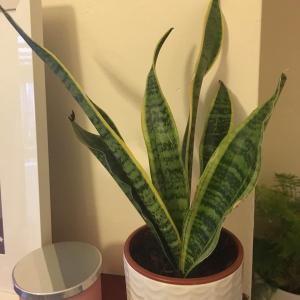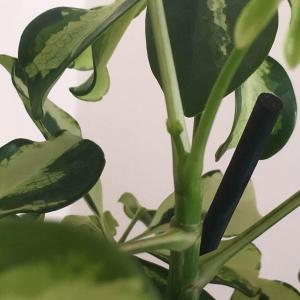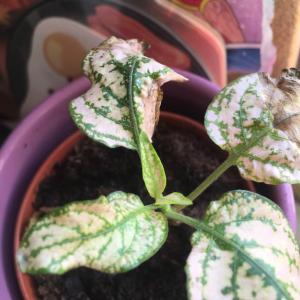成长记
Susi 🌿
2018年04月09日

New flower bud after attacked by kind of insects, I dont know the name it looks like mite?or fly? >:


0
0
Susi 🌿:@meriunkat thanks for your suggestion, Meri. Im glad I saw it quite before it is too serious. I sprayed insecticide on it yesterday, and checked again this morning. The pests are killed but the damage had been made lol, there are many tiny spots on leaves and flower bud, maybe from the bites
meriunkat:You should buy Rose & Flower insecf killer pesticide its $4.99 and kills Aphids, cutworms,earwigs,spiders, and stink bugs. Aphids are the most common enemy of roses and thin leafe succulents. I used it on my plants and kt immediately killed the bugs, i only had to aply twice.
求助
kaylawolfe97
2018年04月06日

I'm not sure what kind of plants these are I'm extremely new to gardening to help with my anxiety and depression and I really don't want to mess up, knowing what kind of succulents/cacti I am caring for seems to be good start, also I don't have and pots for them so I kind of just put them in some tin cans 😂




1
0
meriunkat:I feel like I bought mine for the same reason unconsciously, do those cans have holes underneath? The objects you use as pots need drainage. The first succulent is called either Pachycerous Schottii or Cerus Hidmannianus Subsp. Uruguayanus, a common nickn3is "Fairy Castle". The second succulent is called Kalanchoe Tomentosa, a common nickname is "Panda Plant".
文章
Miss Chen
2018年03月31日

Description: This herbaceous perennial plant is 1-2' tall, branching occasionally. The stems are sharply 4-angled and usually glabrous, although scattered hairs may occur along the ridges on relatively new growth. The opposite leaves are up to 3½" long and 2" across. They are sessile against the stem, or have very short petioles. The leaves are broadly lanceolate or ovate, with serrate margins that are often ciliate. The upper surface of each leaf is often finely pubescent, while a few hairs may occur along the major veins on the lower surface. The upper surface is green or yellowish green, sometimes with scattered purple spots or a purplish tint along the margin. The upper stems terminate in dome-shaped flowerheads (a single flowerhead per stem). These flowerheads are about 1½–3" across. A small wreath of flowers first appears toward the center of the flowerhead, and spreads gradually towards the outer edge of the flowerhead.
Each narrow flower is about 1" long, and has a corolla that is deeply divided into prominent upper and lower lips. The upper lip is nearly tubular and contains the exerted stamens, while the lower lip is somewhat wider and has a narrow lobe at its tip that curls downward. The corolla is white or pink, with purple dots on the lower lip, and white hairs on the upper lip. The calyx of each flower is tubular and hairy, with 5 pointed lobes at its tip. Immediately beneath each flowerhead are 5 leafy bracts that are triangular-shaped. These bracts often have ciliate margins, and they are often colored faded pink or purple. The blooming period occurs during the late spring or early summer and lasts about a month. There is no floral scent, although the foliage exudes an oregano scent. The nutlets are dispersed to some extent by the wind. The root system produces abundant rhizomes, enabling vegetative reproduction.
Cultivation: The preference is partial sun and somewhat dry conditions. This species often grows in soil that is somewhat thin and rocky, which reduces competition from other species of plants. The lower leaves will fall off the stems during drought; in stressed-out plants, the foliage may become discolored and diseased.

Range & Habitat: The native Bradbury's Bee Balm occurs occasionally in the southern half of Illinois, while elsewhere within the state it is rare or absent (see Distribution Map). Habitats include rocky upland forests, savannas, thickets, limestone or sandstone glades, bluffs, meadows in wooded areas, pastures, and roadsides. This species probably benefits from occasional wildfires to create clearings in woodland areas.
Faunal Associations: Long-tongued bees (especially bumblebees), butterflies, skippers, Hummingbird moths, beeflies, and hummingbirds visit the flowers for nectar. The small black bee Doufourea monardae is a specialist pollinator of Monarda spp. Short-tongued Halictid bees may visit the flowers to collect pollen; they are unable to reach the nectar. Caterpillars of the moths Sphinx eremitus (Hermit Sphinx), Anterastria teratophora (Gray Marvel), Pyrausta orphisalis (Pyralid Moth sp.), and Pyrausta signatalis (Pyralid Moth sp.) feed destructively on Monarda spp. (Bee Balms). Other insect feeders include the scentless plant bug Arhyssus nigristernum, the leaf-footed bug Euthochtha galeator, the aphid Hyalomyzus monardae, and the leaf beetle Physonota unipunctata. Mammalian herbivores usually avoid consumption of Monarda spp. – it is possible that the oregano scent of the foliage deters them.

Photographic Location: An upland savanna at Warbler Woods in Coles County, Illinois, and a restored prairie at Meadowbrook Park in Urbana, Illinois.
Comments: Bradbury's Bee Balm is fairly easy to identify. Like other Monarda spp., the large flowers have a distinctive appearance that is showy and attractive. Bradbury' Bee Balm differs from other Monarda spp. in Illinois by its sessile or nearly sessile leaves, and the purple dots on the lower lip of the corolla. It is also shorter in stature and blooms earlier. The species Monarda russeliana of some authors is probably the same species as Monarda bradburiana.
Each narrow flower is about 1" long, and has a corolla that is deeply divided into prominent upper and lower lips. The upper lip is nearly tubular and contains the exerted stamens, while the lower lip is somewhat wider and has a narrow lobe at its tip that curls downward. The corolla is white or pink, with purple dots on the lower lip, and white hairs on the upper lip. The calyx of each flower is tubular and hairy, with 5 pointed lobes at its tip. Immediately beneath each flowerhead are 5 leafy bracts that are triangular-shaped. These bracts often have ciliate margins, and they are often colored faded pink or purple. The blooming period occurs during the late spring or early summer and lasts about a month. There is no floral scent, although the foliage exudes an oregano scent. The nutlets are dispersed to some extent by the wind. The root system produces abundant rhizomes, enabling vegetative reproduction.
Cultivation: The preference is partial sun and somewhat dry conditions. This species often grows in soil that is somewhat thin and rocky, which reduces competition from other species of plants. The lower leaves will fall off the stems during drought; in stressed-out plants, the foliage may become discolored and diseased.

Range & Habitat: The native Bradbury's Bee Balm occurs occasionally in the southern half of Illinois, while elsewhere within the state it is rare or absent (see Distribution Map). Habitats include rocky upland forests, savannas, thickets, limestone or sandstone glades, bluffs, meadows in wooded areas, pastures, and roadsides. This species probably benefits from occasional wildfires to create clearings in woodland areas.
Faunal Associations: Long-tongued bees (especially bumblebees), butterflies, skippers, Hummingbird moths, beeflies, and hummingbirds visit the flowers for nectar. The small black bee Doufourea monardae is a specialist pollinator of Monarda spp. Short-tongued Halictid bees may visit the flowers to collect pollen; they are unable to reach the nectar. Caterpillars of the moths Sphinx eremitus (Hermit Sphinx), Anterastria teratophora (Gray Marvel), Pyrausta orphisalis (Pyralid Moth sp.), and Pyrausta signatalis (Pyralid Moth sp.) feed destructively on Monarda spp. (Bee Balms). Other insect feeders include the scentless plant bug Arhyssus nigristernum, the leaf-footed bug Euthochtha galeator, the aphid Hyalomyzus monardae, and the leaf beetle Physonota unipunctata. Mammalian herbivores usually avoid consumption of Monarda spp. – it is possible that the oregano scent of the foliage deters them.

Photographic Location: An upland savanna at Warbler Woods in Coles County, Illinois, and a restored prairie at Meadowbrook Park in Urbana, Illinois.
Comments: Bradbury's Bee Balm is fairly easy to identify. Like other Monarda spp., the large flowers have a distinctive appearance that is showy and attractive. Bradbury' Bee Balm differs from other Monarda spp. in Illinois by its sessile or nearly sessile leaves, and the purple dots on the lower lip of the corolla. It is also shorter in stature and blooms earlier. The species Monarda russeliana of some authors is probably the same species as Monarda bradburiana.
0
0
成长记
cclecombe
2018年03月07日

Finally a new leaf is on the way!


2
0
Mohamad.hamidizade:@cclecombe this is good plant 💪🏼
cclecombe:@Mohamad.hamidizade I can’t really help there! I bought this plant as a baby
Mohamad.hamidizade:After reproduction of the mother plant of ficus how many make sprout from new stems?
Mohamad.hamidizade:👏🏼👏🏼
成长记
cclecombe
2018年03月03日

Since I’ve mived her to a sunnier spot, she’s got her colour back! She seems to be growing new leaves well too!
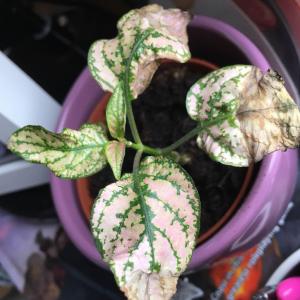

1
0






